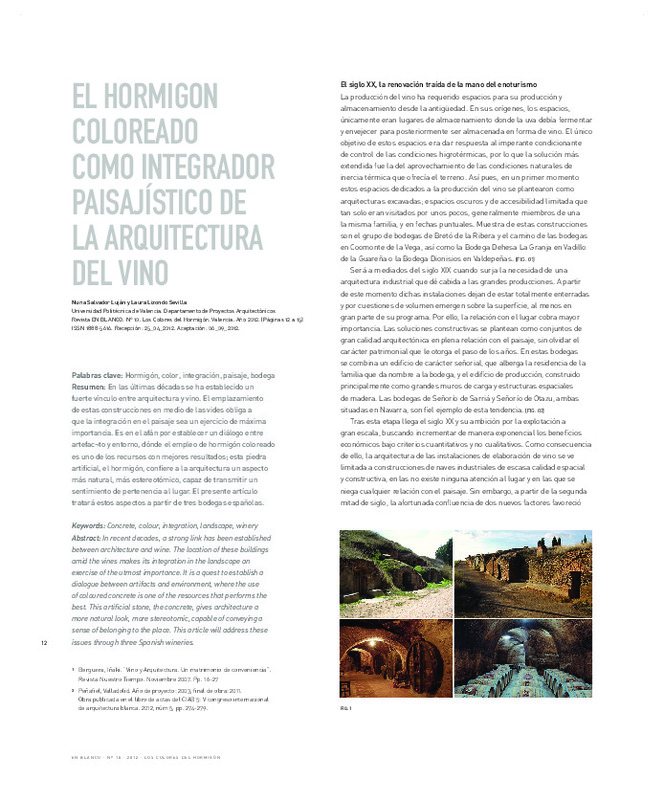JavaScript is disabled for your browser. Some features of this site may not work without it.
Buscar en RiuNet
Listar
Mi cuenta
Estadísticas
Ayuda RiuNet
Admin. UPV
El hormigón coloreado como integrador paisajístico de la arquitectura del vino
Mostrar el registro sencillo del ítem
Ficheros en el ítem
| dc.contributor.author | Salvador Luján, Nuria
|
es_ES |
| dc.contributor.author | Lizondo Sevilla, Laura
|
es_ES |
| dc.date.accessioned | 2018-09-24T10:48:06Z | |
| dc.date.available | 2018-09-24T10:48:06Z | |
| dc.date.issued | 2012-12-18 | |
| dc.identifier.issn | 1888-5616 | |
| dc.identifier.uri | http://hdl.handle.net/10251/107971 | |
| dc.description.abstract | [EN] In recent decades, a strong link has been established between architecture and wine. The location of these buildings amid the vines makes its integration in the landscape an exercise of the utmost importance. It is a quest to establish a dialogue between artifacts and environment, where the use of coloured concrete is one of the resources that performs the best. This artifi cial stone, the concrete, gives architecture a more natural look, more stereotomic, capable of conveying a sense of belonging to the place. This article will address these issues through three Spanish wineries. | es_ES |
| dc.description.abstract | [ES] En las últimas décadas se ha establecido un fuerte vínculo entre arquitectura y vino. El emplazamiento de estas construcciones en medio de las vides obliga a que la integración en el paisaje sea un ejercicio de máxima importancia. Es en el afán por establecer un diálogo entre artefacto y entorno, dónde el empleo de hormigón coloreado es uno de los recursos con mejores resultados; esta piedra artificial, el hormigón, confiere a la arquitectura un aspecto más natural, más estereotómico, capaz de transmitir un sentimiento de pertenencia al lugar. El presente artículo tratará estos aspectos a partir de tres bodegas españolas. | es_ES |
| dc.language | Español | es_ES |
| dc.publisher | Universitat Politècnica de València | |
| dc.relation.ispartof | EN BLANCO. Revista de Arquitectura | |
| dc.rights | Reconocimiento - No comercial (by-nc) | es_ES |
| dc.subject | Hormigón | es_ES |
| dc.subject | Color | es_ES |
| dc.subject | Integración | es_ES |
| dc.subject | Paisaje | es_ES |
| dc.subject | Bodega | es_ES |
| dc.subject | Concrete | es_ES |
| dc.subject | Colour | es_ES |
| dc.subject | Integration | es_ES |
| dc.subject | Landscape | es_ES |
| dc.subject | Winery | es_ES |
| dc.title | El hormigón coloreado como integrador paisajístico de la arquitectura del vino | es_ES |
| dc.title.alternative | Coloured concrete as a landscape integrator in wine architecture | es_ES |
| dc.type | Artículo | es_ES |
| dc.date.updated | 2018-09-24T10:27:33Z | |
| dc.identifier.doi | 10.4995/eb.2012.6657 | |
| dc.rights.accessRights | Abierto | es_ES |
| dc.contributor.affiliation | Universitat Politècnica de València. Departamento de Proyectos Arquitectónicos - Departament de Projectes Arquitectònics | es_ES |
| dc.contributor.affiliation | Universitat Politècnica de València. Escuela Técnica Superior de Arquitectura - Escola Tècnica Superior d'Arquitectura | es_ES |
| dc.description.bibliographicCitation | Salvador Luján, N.; Lizondo Sevilla, L. (2012). El hormigón coloreado como integrador paisajístico de la arquitectura del vino. EN BLANCO. Revista de Arquitectura. 4(10):12-15. https://doi.org/10.4995/eb.2012.6657 | es_ES |
| dc.description.accrualMethod | SWORD | es_ES |
| dc.relation.publisherversion | https://doi.org/10.4995/eb.2012.6657 | es_ES |
| dc.description.upvformatpinicio | 12 | es_ES |
| dc.description.upvformatpfin | 15 | es_ES |
| dc.type.version | info:eu-repo/semantics/publishedVersion | es_ES |
| dc.description.volume | 4 | |
| dc.description.issue | 10 | |
| dc.identifier.eissn | 2445-1215 |








